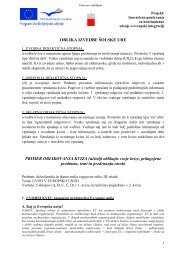national system of innovation in slovenia - Mednarodni odnosi
national system of innovation in slovenia - Mednarodni odnosi
national system of innovation in slovenia - Mednarodni odnosi
Create successful ePaper yourself
Turn your PDF publications into a flip-book with our unique Google optimized e-Paper software.
Macroeconomic performance and framework conditions for <strong><strong>in</strong>novation</strong><br />
25<br />
Accord<strong>in</strong>g to the CIS 2004 the share <strong>of</strong> <strong>in</strong>novative firms that operate <strong>in</strong> domestic<br />
market only is 10 %, the share <strong>of</strong> <strong>in</strong>novative firms among exporters is 25 %, among<br />
foreign affiliates 35 %, while the highest – 42 % – share is found among domestic<br />
outward <strong>in</strong>vestors (headquarters <strong>of</strong> MNEs) (Jaklič 2006). Damijan et al. (2010)<br />
found evidence that exports <strong>in</strong>crease the probability <strong>of</strong> becom<strong>in</strong>g an <strong>in</strong>novator<br />
(a process or a product one), and that export<strong>in</strong>g leads to productivity improvements<br />
(the effect is especially strong for medium and large first time exporters).<br />
Burger et al. (2008) revealed that export<strong>in</strong>g firms are more <strong>in</strong>novative and productive<br />
already before export<strong>in</strong>g and also confirmed the effect <strong>of</strong> »learn<strong>in</strong>g by<br />
export<strong>in</strong>g« <strong>in</strong> the first two years after the beg<strong>in</strong>n<strong>in</strong>g <strong>of</strong> export. While the impact<br />
<strong>of</strong> <strong>in</strong>ward <strong>of</strong> FDI on <strong><strong>in</strong>novation</strong> capacity on the case <strong>of</strong> Slovenian firms has not<br />
been significant, the <strong><strong>in</strong>novation</strong> capacity was found as one <strong>of</strong> the most important<br />
determ<strong>in</strong>ant <strong>of</strong> outward FDI and creation <strong>of</strong> Slovenian multi<strong>national</strong> enterprises<br />
(Jaklič 2006). Direct presence on foreign market and <strong>in</strong>ter<strong>national</strong> production has<br />
also vice versa serve as <strong>in</strong>centive for <strong><strong>in</strong>novation</strong> activity (Jaklič 2006). Outward<br />
<strong>in</strong>ter<strong>national</strong>ization has thus been identified as one <strong>of</strong> the most important drivers<br />
<strong>of</strong> <strong><strong>in</strong>novation</strong> and consequently an <strong>in</strong>centive for firms’ growth and development.<br />
2.4 Framework conditions for <strong><strong>in</strong>novation</strong><br />
2.4.1 Entrepreneurial culture<br />
Entrepreneurial activity is generally assumed to be an important aspect <strong>of</strong> the<br />
<strong>in</strong>dustries that are most conducive to <strong>in</strong>novative activity and unrestra<strong>in</strong>ed competition.<br />
Innovation is also <strong>of</strong>ten associated with firm creation, whereby new enterprises<br />
are set up to provide the market with new <strong>of</strong>fer<strong>in</strong>gs, thus creat<strong>in</strong>g new<br />
jobs. Stel, Carree and Thurik (2005) found that entrepreneurial activity by nascent<br />
entrepreneurs and owner/managers <strong>of</strong> young bus<strong>in</strong>esses affects economic growth,<br />
but that this effect depends upon the level <strong>of</strong> per capita <strong>in</strong>come. Entrepreneurship<br />
thus plays a different role <strong>in</strong> countries <strong>in</strong> different stages <strong>of</strong> economic development.<br />
Moreover, over time, as well as the creation <strong>of</strong> new firms, <strong><strong>in</strong>novation</strong> can<br />
lead to the expansion <strong>of</strong> exist<strong>in</strong>g firms, through <strong>in</strong>creased demand for their products<br />
or through <strong>in</strong>creased competitiveness. At the same time, <strong><strong>in</strong>novation</strong> can see<br />
firm closures, if products or services become obsolete or if they are displaced by<br />
more competitive <strong>of</strong>fer<strong>in</strong>gs.<br />
The Global Entrepreneurship Monitor (GEM) research shows that <strong>in</strong> 2009 3.2 %<br />
<strong>of</strong> adult population <strong>in</strong> Slovenia owned a company for less than 3 months (nascent<br />
entrepreneurs), 2.14 % had a company for more than 3 months but for less than<br />
42 months (new bus<strong>in</strong>ess owners), while 5.6 % <strong>of</strong> the adult population <strong>in</strong> Slovenia<br />
owned a company for more than 42 months (established bus<strong>in</strong>ess owners). In<br />
terms <strong>of</strong> the early-stage entrepreneurial activity (TEA <strong>in</strong>dex), these results rank





